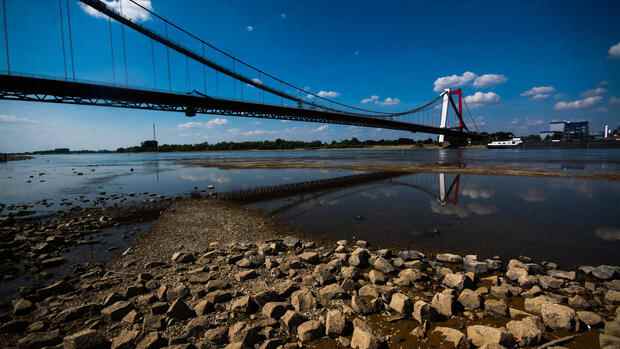The fairways for commercial shipping are significantly deeper than the water level according to the gauge.
(Photo: IMAGO/NurPhoto)
Emmerich Because of the drought, the level of the Rhine in Emmerich has reached a historic low of zero centimeters just before the Dutch border. The value 0.0 was determined on Tuesday morning, said an employee of the waterways and shipping administration in Emmerich of the dpa. That is a drop of four centimeters from Monday morning’s measurement. As early as Monday afternoon, only two centimeters had been measured.
According to the information, the previous low was on October 30, 2018 with a daily average of seven centimeters. At that time, four centimeters were measured as the daily low. Even if the actual level meter dries up due to low water, even minus values can be recorded with a second data collector in Emmerich.
The water levels are not to be confused with the lowest point in the river. The fairways for commercial shipping are significantly deeper than the water level according to the gauge. This only shows the difference between the water surface and the so-called zero level, which is not at the deepest point of the river bed. On Monday, the fairway near Emmerich was still almost two meters deep.
German industry is sounding the alarm because of the low water levels on German waterways. “It is only a matter of time before plants in the chemical or steel industry are shut down, mineral oils and building materials do not reach their destination or large-volume and heavy transports can no longer be carried out,” said Holger Loesch, deputy general manager of the Federal Association of Germans on Tuesday Industry. The consequences would be delivery bottlenecks, production cutbacks or standstills and short-time work.
Top jobs of the day
Find the best jobs now and
be notified by email.
The persistent dry period and low water threatened the security of supply for industry. “Companies are preparing for the worst. The already tense economic situation in the companies is getting worse,” says Loesch.
The energy emergency could worsen
“Inland waterway vessels are currently operating at minimal capacity, if at all. Switching from inland waterways to rail and road will be difficult this summer due to the bottlenecks on the rails, the corona pandemic and the lack of drivers.” The extremely low water could also further exacerbate the energy supply emergency. “The political plans to temporarily rely more on coal in view of the gas crisis are being thwarted by massive transport bottlenecks. In addition to coal transport, fuel supply also depends on transport via waterways.”
Loesch demanded that the federal government, together with the federal states, the logistics sector and industry, must introduce close monitoring in order to be able to react to impending bottlenecks on the waterways at an early stage.
Cargo and passenger ships in particular have been struggling with low water for weeks. Inland waterway skippers must take the draft of the ship into account when loading their cargo. When the water levels are low, they can carry less freight – at some point the transport becomes uneconomical.
A level of 33 centimeters was measured on Tuesday at the Kaub level, one of the flattest places on the Middle Rhine between Koblenz and Bingen. On Monday evening it was still 31 centimeters. According to the authority’s forecast, the water level could fluctuate between 31 and 34 centimeters by Friday.
Rising water level expected in Cologne
For the Cologne level, the experts are forecasting rising levels from Thursday. On Tuesday, 74 centimeters were measured here, just seven centimeters more than the record low of 67 centimeters.
Because rain is expected in the Rhineland on Thursday and Friday, the level should then rise towards the one-meter mark.
More: After the gas shortage, there is a threat of electricity shortages – How the drought endangers Europe’s supply
